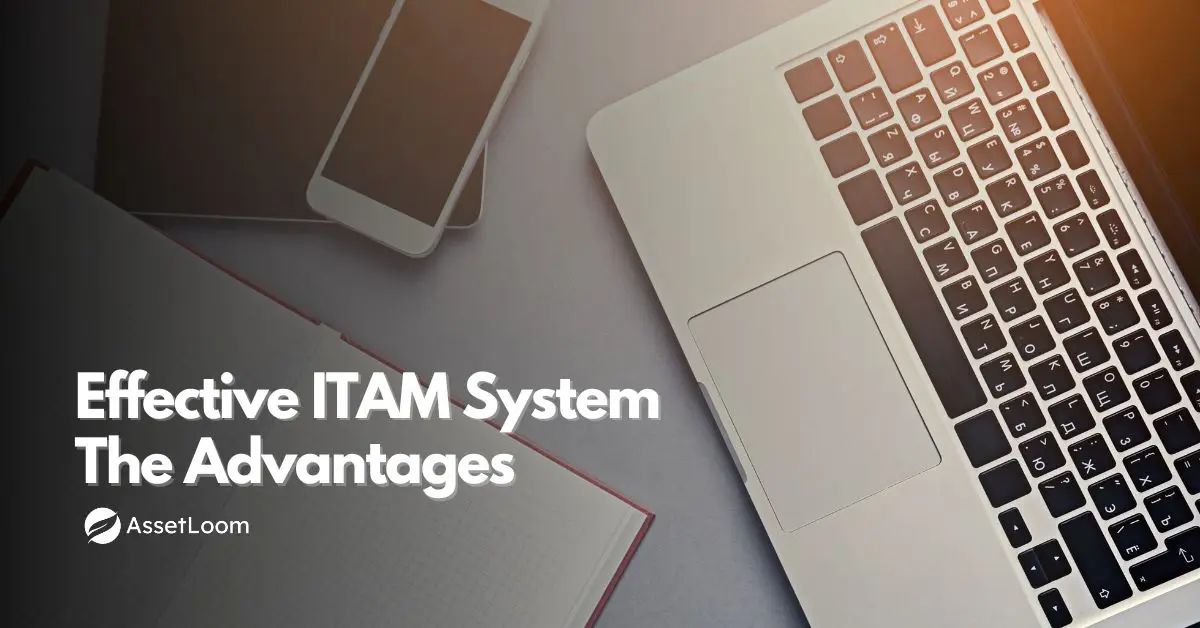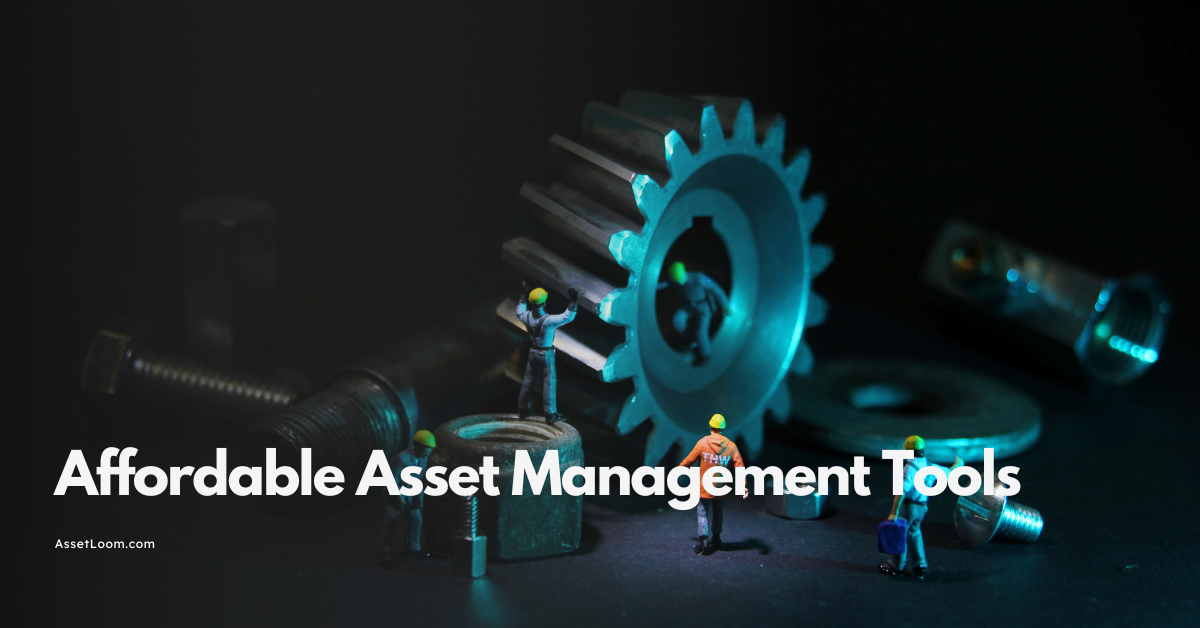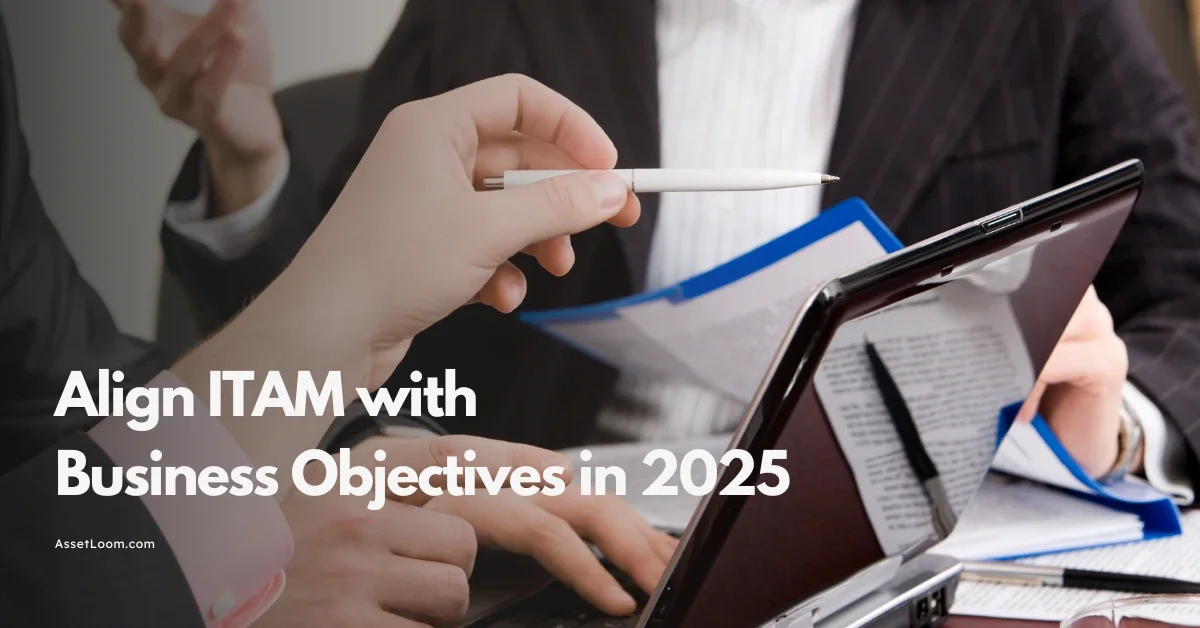The Power of AI in Managing IT Assets: What You Need to Know
Explore how AI is revolutionizing the way businesses are managing IT assets; streamlining operations, cutting costs, and improving decision-making across the board.
Managing IT assets; whether it’s hardware, software, or anything in between; has never been more complex. With the rise of remote work, cloud solutions, and the sheer volume of devices in use, keeping track of everything can feel like a never ending game of whack-a-mole.
Traditional IT Asset Management (ITAM) processes, like relying on spreadsheets or outdated CMDBs, just can’t keep up. So, it’s no surprise that many IT teams are feeling the pressure to stay organized, compliant, and cost-effective without burning out.
But what if there was a way to make all of this easier and smarter, even? Enter AI: no longer a futuristic buzzword but a real tool that’s starting to reshape how IT asset management is done.
In this post, we’ll explore how AI is transforming ITAM by tackling the pain points that have long held back IT teams. From automating repetitive tasks to making smarter, data-driven decisions, AI is here to help you manage your IT assets more effectively—and ultimately, free up your team to focus on more strategic goals.
Ready to see how AI can work for you? Let’s dive in.
Exploring the Trends in AI-Enhanced IT Asset Management
AI isn’t just an emerging trend in IT asset management, it’s becoming essential as businesses face increasing complexity in managing their IT resources. Here’s why AI’s role in ITAM is expanding rapidly:
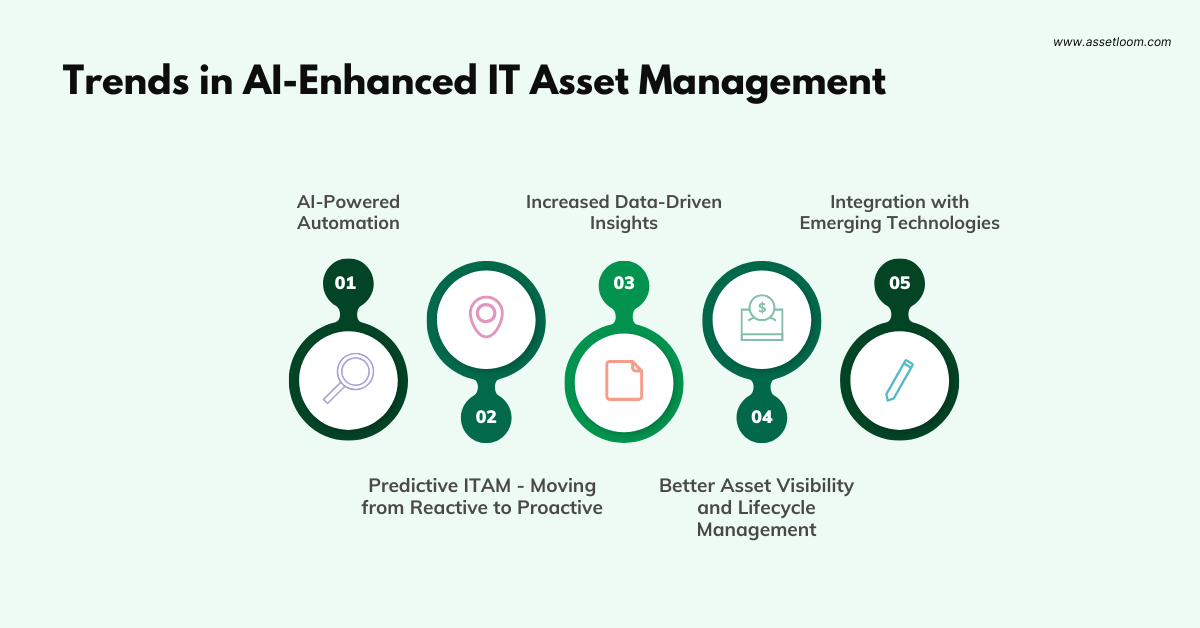
1. The Rise of AI-Powered Automation
Automation is at the forefront of AI’s impact in managing it assets. By automating repetitive and time consuming tasks, such as asset discovery, tracking, and reporting, AI frees up valuable time for IT teams. AI systems can automatically scan and catalog devices, manage licenses, and update asset statuses without human intervention, ensuring real-time visibility and reducing manual errors. This boosts efficiency and significantly cuts down on administrative work.
2. Predictive ITAM: Moving from Reactive to Proactive
Traditional IT asset management is often reactive. Problems like asset failures, licensing issues, or compliance violations are dealt with when they occur. However, AI enables predictive ITAM, where AI tools analyze historical data to forecast asset needs, failures, and even optimize software usage. By spotting patterns early, IT teams can make proactive decisions, such as renewing software licenses ahead of time or scheduling maintenance for critical hardware before it fails.
3. Increased Data-Driven Insights
AI excels in processing vast amounts of data and extracting actionable insights. With AI-powered analytics, IT asset managers can gain deeper insights into asset utilization, performance, and lifecycle status. For instance, AI can identify underused software that could be optimized or highlight hardware nearing the end of its lifecycle, providing actionable intelligence to make cost-saving decisions.
4. Better Asset Visibility and Lifecycle Management
In a traditional ITAM setup, visibility into asset status can be scattered, especially with remote workforces or multi-location environments. AI enhances asset visibility by providing a centralized, real-time view of all assets across the organization. This means no more surprises when it comes to missing devices, outdated software, or expired licenses. Furthermore, AI aids in lifecycle management by tracking assets from acquisition to disposal, ensuring that no asset is left unmanaged.
5. Integration with Emerging Technologies
AI doesn’t exist in a vacuum. It’s increasingly being integrated with other emerging technologies, such as IoT (Internet of Things), blockchain, and cloud platforms. IoT-enabled devices, for example, provide real-time data that AI can analyze to determine asset health and predict failures. AI-powered blockchain systems can secure and validate asset data, improving the accuracy of asset tracking and audits.
Where AI Delivers the Biggest Wins in Managing IT Assets
AI doesn’t just improve asset management, it transforms it by solving some of the most persistent pain points IT professionals face. Here’s how:
1. Poor Visibility? AI Auto-Discovers and Maps Assets in Real-Time
Gone are the days of manual asset tracking and endless spreadsheets. AI-powered tools continuously discover new assets as they appear, classify them, and update the asset registry in real-time. This level of automated visibility means IT teams can get an accurate snapshot of all assets; no more guessing about what’s in use or what’s been forgotten in storage.
2. Too Many Manual Tasks? AI Automates Tracking and Reporting
A lot of time in ITAM is spent on mundane tasks like updating records or manually tracking software usage. AI can handle these routine processes with ease. From automating asset updates to generating real-time reports and identifying discrepancies, AI saves valuable time for your team, allowing them to focus on strategic priorities instead of busywork.
3. Audit Chaos? AI Keeps Documentation Up to Date
Audits are a headache for any IT asset manager, especially when asset records are outdated. AI can help by automating documentation and ensuring that asset information is always current. During audits, AI-powered tools can quickly provide accurate, audit ready data, reducing the time spent preparing for compliance checks and minimizing the risk of non-compliance.
4. License Waste? AI Identifies Underused Software and Flags Cost Savings
Managing software licenses is a constant balancing act—overbuying is expensive, while under-buying can cause compliance issues. AI helps by analyzing usage patterns and identifying unused or underused licenses. This means IT teams can optimize their software purchases and save money on licenses they don’t need, all while ensuring compliance with software agreements.
Benefits of AI in Managing IT Assets
AI isn’t just a flashy upgrade; it’s a real game changer in Managing IT Assets. By automating repetitive tasks and improving decision-making, it helps organizations save time, money, and headaches.
Here’s how:
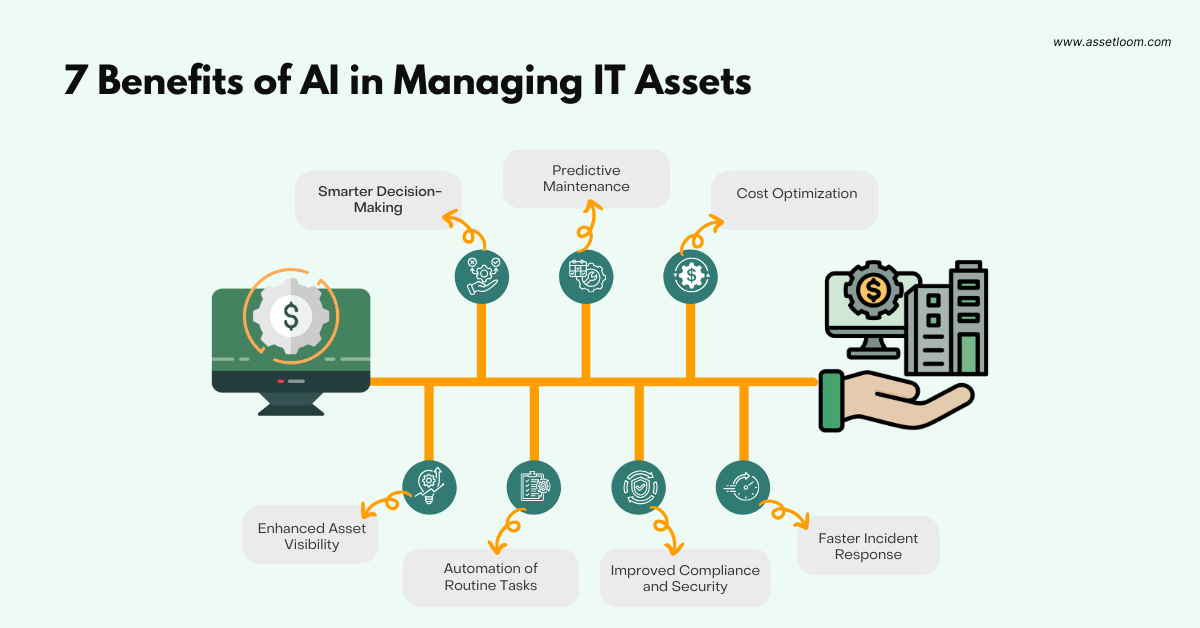
1. Smarter Decision-Making
AI turns raw data into actionable insights. Instead of sifting through spreadsheets or relying on gut instinct, asset managers can see real-time analytics on asset health, usage patterns, and lifecycle trends. This leads to faster, more confident decisions—like when to replace aging hardware or renegotiate a license.
2. Predictive Maintenance
One of AI’s superpowers is spotting problems before they happen. By analyzing maintenance history, usage, and sensor data, AI can predict when an asset is likely to fail. That means fewer surprises, less downtime, and lower repair costs.
3. Cost Optimization
AI helps you find and eliminate waste—like unused software licenses, underutilized hardware, or over-provisioned cloud resources. It can recommend rightsizing assets or consolidating tools, all of which translates to serious savings.
4. Enhanced Asset Visibility
With AI-driven discovery and tracking, you get a clear, real-time view of all your assets—what they are, where they’re located, how they’re being used, and who’s responsible for them. No more guessing, no more ghost assets.
5. Automation of Routine Tasks
AI can handle the boring stuff: inventory updates, license tracking, compliance checks, generating reports. That frees up your team to focus on higher-value work (you know, the things that actually need human brains).
6. Improved Compliance and Security
AI can monitor configurations, user access, and software usage to flag non-compliance or unusual activity. This proactive monitoring reduces the risk of fines and improves your security posture.
7. Faster Incident Response
By integrating with service management tools, AI can speed up root cause analysis and even recommend (or automate) fixes. It’s like giving your help desk a serious IQ boost.
Challenges When Adopting AI in Managing IT Assets
Despite the clear benefits, integrating AI into Managing IT Assets isn’t without its challenges. Here are some roadblocks businesses may encounter when adopting AI solutions:
1. High Initial Costs
Implementing AI in ITAM often requires a significant upfront investment in technology, infrastructure, and tools. AI solutions typically come with high setup costs, including system integration and customization. While the long-term savings are substantial, many businesses struggle with achieving a positive ROI in the early stages of adoption.
2. The Skill Gap
AI is complex, and there’s a shortage of skilled professionals who are proficient in both AI technologies and asset management. This gap means businesses often need to invest in training and development to upskill existing teams or hire specialized talent. Without the right expertise, the full potential of AI in ITAM may not be realized.
3. Ethical and Data Privacy Concerns
AI-driven ITAM relies on vast amounts of data—often sensitive or proprietary. This raises ethical concerns around data privacy, especially when using Generative AI tools. There are also questions around automated decision-making: how transparent and accountable are the AI models? Companies must ensure their AI implementations are compliant with privacy laws and ethical standards.
4. Integration with Existing Systems
Integrating AI solutions into legacy ITAM systems can be a daunting task. Many businesses rely on outdated software or manual processes, which might not easily integrate with advanced AI tools. The integration process may require significant adjustments to workflows, potentially disrupting operations during the transition.
5. Resistance to Change
Adopting AI in ITAM requires organizational buy-in, and not everyone is ready to embrace change. There may be resistance from teams who are accustomed to traditional asset management methods, and convincing them of AI’s benefits can take time. Overcoming this cultural shift and encouraging a mindset change is essential for successful implementation.
Best Practices When Implementing AI in Your ITAM Strategy
Implementing AI in IT asset management is a significant undertaking, but with the right approach, it can drive impressive results. Here are the best practices to follow:
- Assess Current Challenges: Identify manual tasks and areas that AI can streamline, such as asset forecasting and maintenance.
- Prioritize Data Quality: AI is only as smart as the data you give it. Ensure your asset inventory is accurate, up to date, and enriched with lifecycle, usage, and cost data. Better data = better insights.
- Build a Strong Business Case: AI requires investment; so justify it. Show how AI can reduce costs (like unused licenses or unexpected downtime), increase efficiency (automated asset tracking, smarter planning), and reduce risk. Translate these benefits into numbers when possible.
- Start Small, Scale Gradually: Don’t try to automate everything at once. Start with a pilot project say, automating software license tracking and scale from there based on results.
- Get Everyone on Board: Involve stakeholders early; IT, procurement, finance, and leadership. Offer training so your team understands the tools and trusts the insights.
- Continuous Improvement: AI isn’t set it and forget it. Keep your models fresh with new data, stay updated on AI trends, and be ready to tweak processes as your needs evolve.
- Address Ethical Concerns: AI brings new responsibilities. Ensure your systems are transparent, secure, and compliant with data regulations. Don’t overlook fairness and accountability. Especially when AI is making recommendations that affect budgets or compliance.
Conclusion
Managing IT assets is no small feat. Between tracking hardware, juggling software licenses, avoiding compliance missteps, and trying not to overspend; it’s a lot. But with AI in your corner, things get a whole lot smarter.
From predictive maintenance to cost optimization, AI doesn’t just make ITAM more efficient; it makes it strategic. You’ll move from reactive asset tracking to proactive asset optimization. That means better decisions, fewer surprises, and more value from every device, license, and cloud service you manage.
Yes, there are hurdles; costs, complexity, change management; but the long term payoffs? Worth it.
Whether you're just starting out or already testing AI tools, now’s the time to explore how AI can work for you. Start small, focus on high-impact areas, and build from there.
Your assets are already working hard. AI can help them work smarter.

Subscribe for Expert Tips and Updates
Receive the latest news from AssetLoom. right in your inbox
